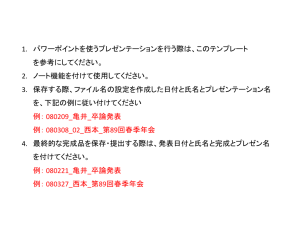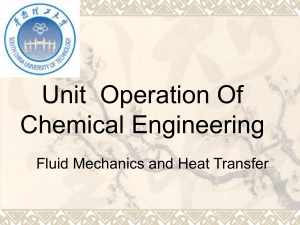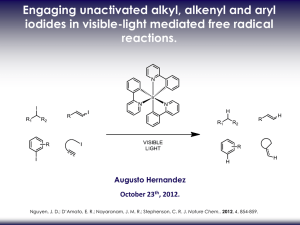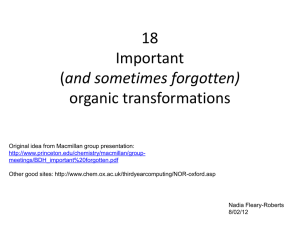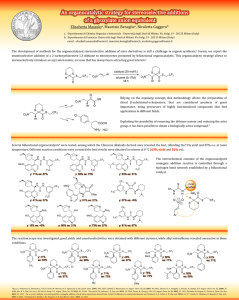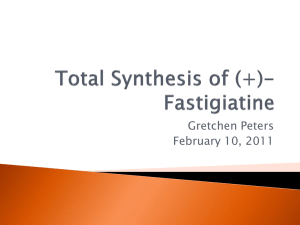manuscript_Bonchioetal_revised_alb
advertisement
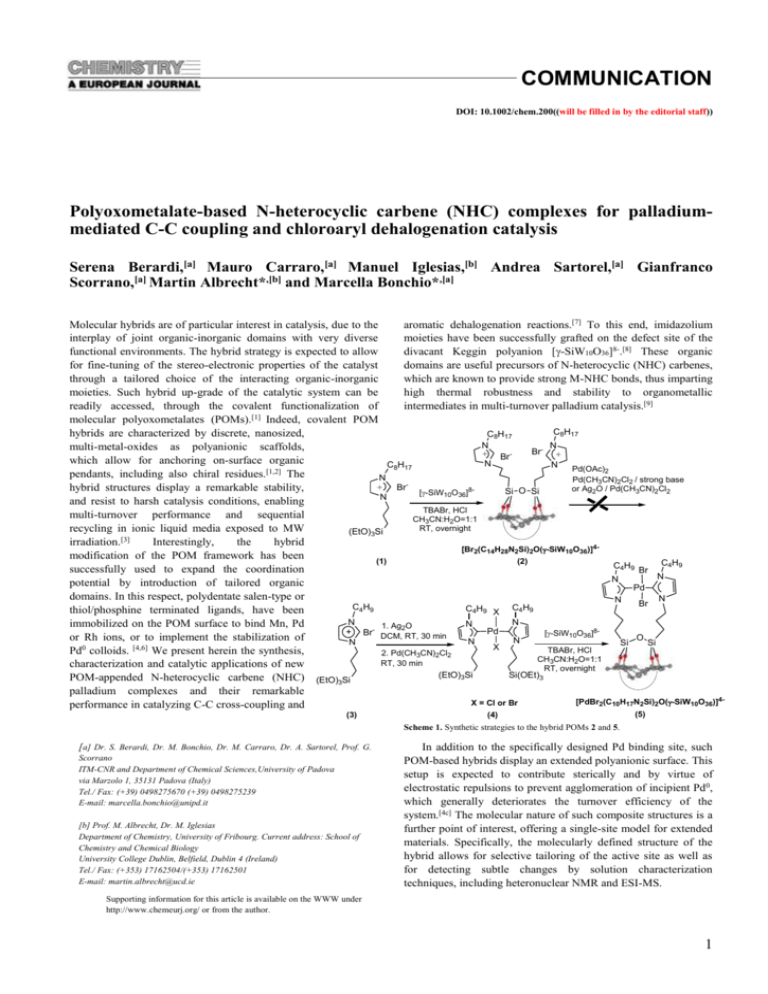
COMMUNICATION
DOI: 10.1002/chem.200((will be filled in by the editorial staff))
Polyoxometalate-based N-heterocyclic carbene (NHC) complexes for palladiummediated C-C coupling and chloroaryl dehalogenation catalysis
Serena Berardi,[a] Mauro Carraro,[a] Manuel Iglesias,[b] Andrea Sartorel,[a] Gianfranco
Scorrano,[a] Martin Albrecht*,[b] and Marcella Bonchio*,[a]
Molecular hybrids are of particular interest in catalysis, due to the
aromatic dehalogenation reactions.[7] To this end, imidazolium
interplay of joint organic-inorganic domains with very diverse
moieties have been successfully grafted on the defect site of the
functional environments. The hybrid strategy is expected to allow
divacant Keggin polyanion [-SiW10O36]8-.[8] These organic
for fine-tuning of the stereo-electronic properties of the catalyst
domains are useful precursors of N-heterocyclic (NHC) carbenes,
through a tailored choice of the interacting organic-inorganic
which are known to provide strong M-NHC bonds, thus imparting
moieties. Such hybrid up-grade of the catalytic system can be
high thermal robustness and stability to organometallic
readily accessed, through the covalent functionalization of
intermediates in multi-turnover palladium catalysis.[9]
[1]
molecular polyoxometalates (POMs). Indeed, covalent POM
C8H17
hybrids are characterized by discrete, nanosized,
C8H17
N
multi-metal-oxides as polyanionic scaffolds,
- N
Br
+ Br+
which allow for anchoring on-surface organic
N
N
C8H17
Pd(OAc)2
pendants, including also chiral residues.[1,2] The
N
Pd(CH3CN)2Cl2 / strong base
Br+
hybrid structures display a remarkable stability,
or Ag2O / Pd(CH3CN)2Cl2
Si O Si
[-SiW10O36]8N
and resist to harsh catalysis conditions, enabling
TBABr, HCl
multi-turnover performance and sequential
CH3CN:H2O=1:1
RT, overnight
recycling in ionic liquid media exposed to MW
(EtO)3Si
irradiation.[3]
Interestingly,
the
hybrid
[Br2(C14H28N2Si)2O(-SiW10O36)]4modification of the POM framework has been
(2)
(1)
C4H9
C4H9
successfully used to expand the coordination
Br
N
N
potential by introduction of tailored organic
Pd
domains. In this respect, polydentate salen-type or
N
N
Br
C4H9
C4H9 X C4H9
thiol/phosphine terminated ligands, have been
N
N
N
immobilized on the POM surface to bind Mn, Pd
1. Ag2O
Pd
+ Br- DCM, RT, 30 min
[-SiW10O36]8O
or Rh ions, or to implement the stabilization of
N
N
N
Si
Si
X
0
[4,6]
TBABr, HCl
Pd colloids.
We present herein the synthesis,
2. Pd(CH3CN)2Cl2
CH3CN:H2O=1:1
RT, 30 min
characterization and catalytic applications of new
RT, overnight
(EtO)
Si
Si(OEt)
3
3
POM-appended N-heterocyclic carbene (NHC) (EtO)3Si
palladium complexes and their remarkable
[PdBr2(C10H17N2Si)2O(-SiW10O36)]4X = Cl or Br
performance in catalyzing C-C cross-coupling and
(3)
(4)
(5)
Scheme 1. Synthetic strategies to the hybrid POMs 2 and 5.
[a] Dr. S. Berardi, Dr. M. Bonchio, Dr. M. Carraro, Dr. A. Sartorel, Prof. G.
Scorrano
ITM-CNR and Department of Chemical Sciences,University of Padova
via Marzolo 1, 35131 Padova (Italy)
Tel./ Fax: (+39) 0498275670 (+39) 0498275239
E-mail: marcella.bonchio@unipd.it
[b] Prof. M. Albrecht, Dr. M. Iglesias
Department of Chemistry, University of Fribourg. Current address: School of
Chemistry and Chemical Biology
University College Dublin, Belfield, Dublin 4 (Ireland)
Tel./ Fax: (+353) 17162504/(+353) 17162501
E-mail: martin.albrecht@ucd.ie
In addition to the specifically designed Pd binding site, such
POM-based hybrids display an extended polyanionic surface. This
setup is expected to contribute sterically and by virtue of
electrostatic repulsions to prevent agglomeration of incipient Pd 0,
which generally deteriorates the turnover efficiency of the
system.[4c] The molecular nature of such composite structures is a
further point of interest, offering a single-site model for extended
materials. Specifically, the molecularly defined structure of the
hybrid allows for selective tailoring of the active site as well as
for detecting subtle changes by solution characterization
techniques, including heteronuclear NMR and ESI-MS.
Supporting information for this article is available on the WWW under
http://www.chemeurj.org/ or from the author.
1
The synthetic route to Keggin-type hybrids involves the
reaction of organosilane reagents with the nucleophilic oxygens,
bordering a defect site on the POM surface. Grafting strategies
have been optimized in acetonitrile where, the presence of excess
n-Bu4NBr promotes the solubilization of the POM by counterion
metathesis (Scheme 1). Under these conditions, decoration of the
lacunary POM is known to yield hybrids with two surfaceanchored organosilyl (RSi-) groups, each one linked to two
oxygen atoms of two edge-shared WO6 octahedra.[4,10]
A first attempt focused on a divergent approach, including the
covalent attachment of the triethoxysilyl-functionalized 4,5dihydro-imidazolium bromide 1 to the divacant decatungosilicate.
The hybrid POM (2) was isolated and displayed spectroscopic
data (1H, 13C, 29Si and 183W NMR, FT-IR) that are in agreement
with the expected bis-functionalized structure. However,
palladation of 2 met little success. Neither direct metalation using
Pd(OAc)2 nor transmetalation using Ag2O resulted in the
formation of the desired palladium NHC complex.[11-13] Similarly,
base-mediated palladation with PdCl2(CH3CN)2 in the presence of
potassium bis(trimethylsilyl)amide (KHMDS) or NaH failed, as
evidenced by the persistence of the 1H NMR resonance of the C2bound protons on the dihydroimidazolium ring (δH 8.1). Analysis
of the reaction by UV-Vis spectrophotomeric titration suggests a
possible electrostatic association of Pd2+ ions to the anionic POM
surface.[14] To avoid such complications, we concentrated on a
convergent approach involving the immobilization of preformed
palladium complexes on the POM. Hence, the trialkoxysilyltagged imidazolium precursor 3 containing an unsaturated
heterocycle and a less hindered n-butyl substituent at the nitrogen
atom[9,15] was synthesized under strictly anhydrous conditions,
from (3-chloropropyl)-triethoxysilane and 1-butylimidazole.
Reaction of 3 with Ag2O followed by transmetallation with
PdCl2(CH3CN)2[13] afforded the Pd biscarbene complex 4, as
confirmed by ESI-MS, 1H and 13C NMR analyses. The absence of
a resonance due to the C2-bound imidazolium proton (H 10.3) is
corroborated by the appearance of a new signal at C 170.6, which
is characteristic of a palladium-bound carbene carbon (SI, Figures
S16 and S15). ESI-MS (positive mode) shows signals centered at
m/z = 799.3 and 843.3, corresponding to the monochloride and
monobromide cationic fragments [{C10H17N2Si(OEt)3}2PdCl]+
and [{C10H17N2Si(OEt)3}2PdBr]+, respectively (SI, Figure S17).
Complex 4 was finally reacted with the divacant Keggin POM [SiW10O36]8- in acetonitrile, under phase transfer conditions
(Scheme 1), leading to the functionalized hybrid 5 in 75%
yield.[10] Complex 5 was characterized both in the solid state (by
FT-IR and elemental analysis) and in solution (1H, 13C, 29Si and
183W NMR, ESI-MS). All spectroscopic results confirmed the
proposed structure (SI, Figures S18-S23).[10] The 183W NMR
spectrum shows three resonances at -107.4, -135.8, and -142.1
ppm in 2:1:2 ratio, in agreement with the expected C2v symmetry.
The 29Si NMR spectrum reveals two signals at -62.8 and -88.4
ppm with integration ratio 2:1. This results are consistent with a
double substitution of the POM surface. Coordination of Pd(II)
has been confirmed by X-ray Photoelectron Spectroscopy (XPS)
of a solid sample of 5, where the expected Pd 3d 5/2 peaks
centered at 338 and 343 eV in binding energy have been observed
(SI, Figures S24-S26). The DFT optimized structure of 5 suggests
a planar distorted coordination for Pd, with trans halide ligands
and bond lengths around 2.07 - 2.11 Å (Pd-C) and 2.59 Å (Pd-Br)
(Scheme 2).
Complex 5 has been tested in the palladium-catalyzed crosscoupling of aryl halides with phenylboronic acids, according to
established Suzuki-Miyaura protocols (Scheme 2, pathway a).[16]
This reaction represents one of the key tools for selective C-C
bond formation. The performance of catalyst 5 in this chemistry
has been screened in 1:1 DMF/H2O mixtures and under
microwave (MW)-induced dielectric heating (Table 1).[17,18] This
latter method is particularly efficient for poly-charged catalysts,
which behave as MW-activated molecular heat-carriers.[19] Indeed,
hybrid POMs, are known to display a remarkable thermal stability
and high catalytic efficiency in MW-assisted processes.[3]
The cross-coupling catalytic activity of 5 was initially
evaluated using a representative range of aryl halides as substrates
and MW irradiation at 10 W for 10–30 min (Table 1).
Scheme 2. Cross-coupling (path a) and dehalogenation reactions (path b) catalyzed
by 5 under MW irradiation. DFT optimized geometry is presented for the proposed
structure for 5.
Table 1. Suzuki coupling catalyzed by 5 under MW-irradiation (Scheme 2, path a).
In all reactions: aryl halide, ArX (0.25 mmol), phenylboronic acid, PhB(OH)2 (1.1
eq, 0.275 mmol), Na2CO3 (2 eq, 0.5 mmol), DMF:H2O=1:1 (0.45:0.45 mL); MWirradiation: W = 10 watt, compressed air at 30-40 psi; Tbulk=75-85°C.
% product
#
X
R1
5 loading
(%)
(time, min)
1a
I
p-COCH3
0.05%
99 (10)
2
I
H
0.05%
85 (30)
3
I
p-CH3
0.05%
80c (20)
4
I
p-OCH3
0.05%
95c (20)
5
Br
p-COCH3
0.1%
99 (10)
6
Br
p-NO2
0.1%
93c (10)
7b
Br
H
0.1%
94 (35)
8b
Br
p-CH3
0.1%
87c (30)
9b
Cl
p-COCH3
1%
98c (30)
10b
Cl
o-COCH3
1%
10d (150)
b
11
Cl
p-CHO
1%
20c (30)
12
Cl
p-NO2
1%
38e (30)
b
13
Cl
H
1%
57 (60)
14b
Cl
p-CH3
1%
33f (60)
a
under analogous conditions, the coupling reaction catalyzed by 4 proceeds with
32% yield. b ArX (0.25 mmol), PhB(OH)2 (1.3 eq, 0.325 mmol), Na2CO3 (3 eq, 0.75
mmol); c biphenyl (1-7%) and dehalogenation products observed in traces; d biphenyl
(4%) and acetophenone (14%) were detected; e biphenyl (18%) was detected; f
biphenyl (9%) and toluene (6%) were detected.
Under these conditions, both activated and deactivated aryl
iodides react smoothly with 0.05 mol% catalyst loading, leading
to the corresponding substituted biphenyl products with up to
99% yield, 1980 turnover numbers (TON), and frequencies (TOF)
2
up to 11880 h-1 (entries 1-4, Table 1, and comparison with
literature benchmarks in Tables S1-S2). In all reactions, the bulk
temperature is kept at ca. 80 °C by simultaneous cooling with
compressed air. Control experiments performed with iodobenzene
and phenylboronic acid indicate no coupling product in the Pdfree reaction, nor in the presence of the imidazoliumfunctionalized POM 2. It is worth noting that the POM-free NHC
complex 4 deactivates rapidly under analogous catalytic regime,
thus yielding poor conversion and turnover efficiency (see note a
in Table 1). Addition of Na2CO3 (2 or 3 equivalents) is an
essential prerequisite of the catalytic protocol, in agreement with
the generally accepted mechanism involving a reactive borate
anion for the transmetallation step.[20] Coupling of aryl bromides
is readily achieved by increasing the catalyst loading to 0.1 mol%,
with similar yields and reaction time (yield up to 99%, TON =
990; TOF = 5940 h-1, entry 5, Table 1). A remarkable 87% yield
of 4-methylbiphenyl was obtained after 30 min irradiation when
using the unactivated 4-bromotoluene as substrate (TOF = 1740 h1, entry 8, Table 1).[21]
The POM-based system was also effective in coupling aryl
chlorides, which are known to be poorly reactive but synthetically
highly appealing.[22,23] An increased catalyst loading (1.0 mol%),
and a larger excess of phenylboronic acid and Na2CO3 (1.3 and 3
equivalents with respect to aryl chloride), were pivotal for ensuing
reactivity. Under such conditions, 4-chloroacetophenone gave the
corresponding coupling product in 98% yield when MWirradiated for 30 minutes (TON = 98, TOF = 196 h-1, entry 9,
Table 1).[24] Ortho-substituted, 2-chloroacetophenone was
converted only sluggishly, presumably due to steric factors (entry
10, Table 1). The POM residue may be sufficiently bulky to
hamper the oxidative addition and/or transmetallation step of the
catalytic cycle.[ 25] Other activated aryl chlorides reacted with less
success, as for 4-chloronitrobenzene, affording a significant
amount (18%) of biphenyl originating from homo-coupling
together with 38% of cross-coupled 4-nitrobiphenyl (entry 12,
Table 1). In this case, the selectivity of the process did not
improve upon increasing the amount of base .[26]
Interestingly, the reaction of the unactivated 4-chlorotoluene
turned out to yield 33% of the desired product, with concurrent
homo-coupling (<9%) and dehalogenation to toluene (<10%).[27]
Catalytic dehalogenation was previously reported as a parallel
reaction in Suzuki coupling, however, few papers provide details
on this topic.[28] Such reaction is of major importance from an
environmental point of view, in particular with regards to the
degradation of highly toxic halogenated organic compounds.[29]
Table 2. Dehalogenation of aryl chlorides (ArCl), catalyzed by 5 under MWirradiation (Scheme 2, path b).a
a
ArH Yield, %
(time, min)
#
ArCl
1
4-chloroacetophenone
>99 (30)
2
2-chloroacetophenone
57 (120b)
3
3-chloroacetophenone
86 (60)
4
4-chloronitrobenzene
>99 (40)
5
4-chlorophenol
12 (60)
6
4-chlorotoluene
43 (60)
7
1-chloronaphtalene
87 (60)
ArCl (0.25 mmol), n-Bu4NOH 30H2O (2 eq, 0.5 mmol), 5 (1 mol%, 0.0025 mmol),
DMF (0.5 ml); MW-irradiation: W = 10 watt, compressed air at 30 psi; Tbulk=8095°C. b after 3 cycles (2 x 30 min + 1 x 60 min).
The
proposed
mechanism
of
palladium-catalyzed
dehalogenation involves the oxidative addition of the aryl halide
to the Pd(0)-NHC intermediate, and the formation of a Pd(II)hydride species, generated by a strong base such as an
alkoxide.[29,30] In line with this proposal, the dehalogenation
reaction is strongly promoted upon changing the base from
Na2CO3 to n-Bu4NOH.[31] Under conditions that are otherwise
identical to the Suzuki protocol, catalytic dehalogenation of aryl
chlorides was readily accomplished (Scheme 2, pathway b). In the
presence of n-Bu4NOH as the base, 4-chloroacetophenone and
phenyl boronic acid, dehalogenated acetophenone was formed as
the major product (63% yield), together with 4-acetylbiphenyl in
35% yield. The competitive dehalogenation reaction has thus been
investigated in more detail. Highest selectivites were achieved
when using 2 equivalents of n-Bu4NOH in DMF, under MW
irradiation (Table 2). Under these conditions, a formate ion is
surmised to be generated from DMF and hydroxide, as the
hydrogen donor.[32] Dehalogenation of activated aryl chlorides
occurs smoothly and quantitative yields were reached within 3040 min (entries 1 and 4, Table 2).[33] Sterically hindered 2chloroacetophenone was converted at a slower rate and afforded
57% acetophenone after 2 h (entry 2, Table 2). Aryl chlorides
with electron-donating substituents were dehalogenated less
efficiently (entries 5-6, Table 2). Nevertheless, 4-chlorotoluene
yielded appreciable 43% of toluene after irradiation for 1 h (entry
6, Table 2).
In conclusion, a novel synthetic route to hybrid Pd catalysts
has been developed through decoration of a POM surface with
imidazolium-based NHC palladium complexes. The interplay of
the Pd binding domains with the inorganic scaffold provides new
opportunities to access multi-turnover catalysis with good to
excellent performance under MW-assisted protocols. Depending
on the reaction conditions, both cross-coupling and dechlorination
of aromatic compounds are efficiently accomplished. Future
studies will concentrate on optimizing the carbene domain, in
particular with respect to steric effects and the Pd:carbene ratio.
The introduction of the POM platform is potentially amenable
to nanofiltration techniques for catalyst recovery and product
purification, while being instrumental for heterogeneization
strategies on charged surfaces/supports.[34] In this respect, a
straightforward up-grade of the system in ionic liquid phases can
be envisaged due to the implemented affinity of such POM-based
hybrids for these media. [35]
Acknowledgements
Financial support from CNR, MIUR, University of Padova,
(Progetto Strategico 2008, HELIOS, prot. STPD08RCX and
PRAT CPDA084893), the Alfred Werner Foundation (to M.A.)
and ESF COST D40 action are gratefully acknowledged. We
thank Dr. Marta. M. Natile for the XPS analysis.
Keywords: Polyoxometalates,
Homogeneous Catalysis.
[1]
Carbenes,
Palladium,
a) M. Carraro, A. Sartorel, G. Scorrano, C. Maccato, M. H. Dickman, U.
Kortz, M. Bonchio Angew. Chem. Int. Ed. 2008, 47, 7275-7279. b) M.
Carraro, G. Modugno, A. Sartorel G. Scorrano, M. Bonchio Eur. J. Inorg.
Chem. 2009, 5164–5174.
3
[2]
a) M. T. Pope, A. Müller, in Polyoxometalate Chemistry. From topology via
self-assembly to applications, Kluwer Academic Publishers, Dordrecht, The
Netherlands, 2002. b) C. Sanchez, G. J. de Soler-Illia, F. Ribot, T. Lalot, C.
R. Mayer, V. Cabuil Chem. Mater. 2001, 13, 3061-3083. c) D. L. Long, E.
Burkholder, L. Cronin Chem. Soc. Rev. 2007, 36, 105-121.
[3]
a) S. Berardi, M. Bonchio, M. Carraro, V. Conte, A. Sartorel, G. Scorrano,
J. Org. Chem. 2007, 72, 8954–8957; b) M. Carraro, L. Sandei, A. Sartorel,
G. Scorrano, M. Bonchio, Org. Lett. 2006, 8, 3671–3674. c) M. Bonchio,
M. Carraro, A. Bagno, G. Scorrano Adv. Synth. Catal. 2004, 346, 648-654.
[4]
a) I. Bar-Nahum, R. Neumann Chem. Commun., 2003 2690–2691. b) I. BarNahum, H. Cohen, R. Neumann Inorg. Chem. 2003, 42, 3677-3684. c) M.
De bruyn, R. Neumann Adv. Synth. Catal. 2007, 349, 1624– 1628.
[5]
S. Favette, B. Hasenknopf, J. Vaissermann, P. Gouzerh, C. Roux Chem.
Commun. 2003, 2664–2665.
[6]
a) V. Kogan, Z. Aizenshtat, R. Popovitz-Biro, R. Neumann Org. Lett. 2002,
4, 3529-3532. b) V. Kogan, Z. Aizenshtata, R. Neumann New J. Chem.,
2002, 26, 272–274.
homogeneous Suzuki coupling of deactivated aryl bromides. N. Marion, O.
Navarro, J. Mei, E. D. Stevens, N. M. Scott, S. P. Nolan J. Am.Chem. Soc.
2006, 128, 4101–4111.
[22]
A. F. Littke, G. C. Fu Angew. Chem. Int. Ed. 2002, 41, 4176-4211.
[23]
Ligand 2 in combination with Pd(Ac)2 (1 equivalent) was found to be
inactive with chloroaryl substrates, thus confirming the superior
performance of the POM based NHC-ligand in this chemistry.
[24]
Literature TON and TOF values, for Suzuki coupling of aryl chlorides by
Pd-NHC catalysts are in the range 40-100 h-1. See for example: a) Z. Jin, S.X. Guo, X.-P. Gu, L.-L. Qiu, H.-B. Song, J.-X. Fang Adv. Synth. Catal.
2009, 351, 1575-1585. b) R. Singh, M. S. Viciu, N. Kramareva, O. Navarro,
S. P. Nolan Org. Lett. 2005, 7, 1829-1832.
[25]
a) O. Diebolt, P. Braunstein, S. P. Nolan, C. S. J. Cazin Chem. Commun.
2008, 3190–3192. b) G. Altenhoff, R. Goddard, C. W. Lehmann, F. Glorius
Angew. Chem. Int. Ed. 2003, 42, 3690–3693.
[26]
a) M. J. Burns, I. J. S. Fairlamb, A. R. Kapdi, P. Sehnal, R. J. K. Taylor
Org. Lett. 2007, 9, 5397-5400. b) R. Rodríguez González, L. Liguori, A.
Martinez Carrillo, H.-R. Bjørsvik J. Org. Chem. 2005, 70, 9591-9594. c) G.
Dyker, A. Kellner J. Organomet. Chem. 1998, 555, 141-144.
[7]
J. Tsuji, in Palladium Reagents and Catalysts, John Wiley & Sons Ltd.:
Chichester, U.K., 1995.
[8]
J. Canny, A. Tézé, R. Thouvenot, G. Hervé Inorg. Chem. 1986, 25, 21142119.
[27]
M. Moreno-Mañas, M. Pérez, R. Pleixats J. Org. Chem. 1996, 61, 23462351.
[9]
a) W. A. Herrmann Angew. Chem. Int. Ed. 2002, 41, 1290-1309. b) O.
Schuster, L. Yang, H. G. Raubenheimer, M. Albrecht Chem. Rev. 2009,
109, 3445-3478. c) S. Nolan, in N-Heterocyclic Carbenes in Synthesis,
Wiley-VCH Verlag GmbH & Co. KGaA, Weinheim, Federal Republic of
Germany, 2006. d) E. A. B. Kantchev, C. J. O’ Brien, M. G. Organ Angew.
Chem. Int. Ed. 2007, 46, 2768-2813.
[28]
S. T. Handy, H. Bregman, J. Lewis, X. Zhang, Y. Zhang Tetrahedron Lett.
2003, 44, 427–430.
[29]
O. Navarro, H. Kaur, P. Mahjoor, S. P. Nolan J. Org. Chem. 2004, 69,
3173-3130.
[30]
F. Alonso, I. P. Beletskaya, M. Yus Chem. Rev. 2002, 102, 4009-4091.
[10]
C. R. Mayer, I. Fournier, R. Thouvenot Chem. Eur. J. 2000, 6, 105-110.
[31]
[11]
I. Özdemir, M. Yiğit, E. Çetinkaya, B. Çetinkaya Appl. Organomet. Chem.
2006, 20, 187-192.
[12]
T. Weskamp, V. P. W. Bölm, W. A. Herrmann J. Organomet. Chem. 2000,
600, 12-22 and references cited therein.
FT-IR analysis of pre-catalyst 5 (5 mM in DMF) after incubation with nBu4NOH·30 H2O (5 eq) under microwave irradiation for 1h and subsequent
precipitation with water shows retention of the main spectral features
associated to the POM scaffold, with bands at 946 (w), 883 (s), 825 (w),
741 (s), cm-1, indicating that the POM support is stable under catalytically
relevant reaction conditions.
[13]
a) C. K. Lee, J. C. C. Chen, K. M. Lee, C. W. Liu, I. J. B. Lin Chem. Mater.
1999, 11, 1237-1242. b) D. S. McGuinness, K. J. Cavell Organometallics
2000, 19, 741-748. c) M. C. Perry, X. Cui, K. Burgess Tetrahedron:
Asymmetry 2002, 13, 1969–1972.
[32]
a) E. Buncel, E. A. Symons J. Chem Soc., Chem. Commun. 1970, 164-165.
b) Y. Ben-David, M. Gozin, M. Portnoy, D. Milstein J. Mol. Catal. 1992,
73, 173-180.
[33]
[14]
UV-Vis spectrophotometric titration ( < 450 nm), of 2 upon addition of
Pd(OAc)2 in DMSO and incubation at 50°C for 4 h and at 100 °C for 30
min indicates a 1:1 Pd2+: 2 association stoichiometry.
Thermal and photo-redox carbon-halogen bond cleavage by POM catalysts
has been reported to proceed by radical mechanisms (D. Sattari, C. L. Hill
J. Am. Chem. Soc. 1993, 115, 4649-4657). Under the condition explored, no
reaction was observed with the Pd-free complex 2.
[15]
M. B. Andrus, C. Song Org. Lett. 2001, 3, 3761-3764.
[34]
[16]
a) N. Miyaura, A. Suzuki Chem. Rev. 1995, 95, 2457-2483. b) F. Alonso, I.
P. Beletskaya, M. Yus Tetrahedron 2008, 64, 3047-3101.
a) P. T. Witte, S. R. Chowdhury, J. E. ten Elshof, D. Sloboda-Rozner, R.
Neumann, P. L. Alsters Chem. Commun., 2005, 1206–1208. b) S.
R.Chowdhury, J.E. ten Elshof, N.E. Benes, K. Keizer Desalination
2002,144, 41-46.
[17]
H. Qiu, S. M. Sarkar, D.-H. Lee, M.-J. Jin Green Chem. 2008, 10, 37-40.
[35]
a) H. Hagiwara, K. H. Ko, T. Hoshi, T. Suzuki Chem. Commun. 2007,
[18]
a) R. K. Arvela, N. E. Leadbeater Org. Lett. 2005, 7, 2101-2104. b) M.
Marco, N. E. Leadbeater J. Org. Chem. 2003, 68, 888-892. c) R. K. Arvela,
N. E. Leadbeater, M. S. Sangi, V. A. Williams, P. Granados, R. D. Singer J.
Org. Chem. 2005, 70, 161-168.
[19]
a) I. Guryanov, F. M. Toma, Al. Montellano Lopez, M. Carraro, T. Da Ros,
G. Angelini, E. D’Aurizio, A. Fontana, M. Maggini, M. Prato, M. Bonchio
Chem. Eur. J. 2009, 15, 12837–12845. b) I. Guryanov, A. Montellano
Lopez, M. Carraro, T. Da Ros, G. Scorrano, M. Maggini, M. Prato, M.
Bonchio Chem Commun. 2009, 3940–3942.
[20]
A. de Meijere, F. Diederich, in Metal Catalyzed Cross-Coupling Reactions,
Wiley-VCH Verlag GmbH & Co. KGaA, Weinheim, Germany, 2004.
[21]
Average TON and TOF values in the range 1100-1900 and 314-543 h-1
respectively, have been reported for classic NHC-ligands employed in the
2838–2840. b) A. Bordoloi, S. Sahoo, F. Lefebvre, S.B. Halligudi J. Catal.
2008, 259, 232-239.
Received: ((will be filled in by the editorial staff))
Revised: ((will be filled in by the editorial staff))
Published online: ((will be filled in by the editorial staff))
4
Entry for the Table of Contents
Layout 1:
Serena
Berardi,[a]
Mauro
[a]
Carraro,
Manuel
Iglesias,[b]
Andrea Sartorel,[a] Gianfranco
Scorrano,[a] Martin Albrecht,*,[b]
Marcella Bonchio*,[a]
…Page – Page
A novel hybrid N-heterocyclic carbene
(NHC) palladium complex integrating a
totally inorganic and polyanionic
decatungstate unit, has been synthesized
following a convergent strategy. The
interplay of the Pd binding domains with
the inorganic scaffold is instrumental to
access multi-turnover catalysis, in C-C
cross-coupling and aromatic
dehalogenation reactions under MWassisted protocols
1S
Supporting Information for:
Polyoxometalate-based N-heterocyclic carbene (NHC) complexes for palladiummediated C-C coupling and chloroaryl dehalogenation catalysis
Serena Berardi,[a] Mauro Carraro,[a] Manuel Iglesias,[b] Andrea Sartorel,[a] Gianfranco Scorrano,[a]
Martin Albrecht*,[b] and Marcella Bonchio*,[a]
[a]
ITM-CNR and Department of Chemical Sciences, University of Padova via Marzolo 1, 35131 Padova (Italy)
Tel./ Fax: (+39) 0498275670 / (+39) 0498275239 E-mail: marcella.bonchio@unipd.it
[b]
Department of Chemistry, University of Fribourg (Switzerland). Current address: School of Chemistry and
Chemical Biology, University College Dublin, Belfield, Dublin 4, (Ireland) Tel./ Fax: (+353) 17162504 / (+353)
17162501 E-mail: martin.albrecht@ucd.ie
Content
Experimental Section and Spectra
General
Synthesis of 1-octyl-3-(3-triethoxysilylpropyl)-4,5-dihydroimidazolium bromide (1)
Synthesis of (n-Bu4N)2K2[Br2(C14H28N2Si)2O(γ-SiW10O36)] (2)
Synthesis of 1-butyl-3-(3-triethoxysilylpropyl)-imidazolium bromide (3)
Synthesis of dichloro-bis-(1-butyl-3-(3-triethoxysilylpropyl)-imidazol-2-ylidene)palladium(II) (4)
Synthesis of (n-Bu4N)3.5H0.5[PdBr2(C10H17N2Si)2O(-SiW10O36)] (5)
S2
S2
S4
S7
S11
S13
S16
Representative Procedures for the Reactions
S22
Suzuki Coupling Reaction of Aryl Halides with Phenylboronic acid catalyzed by complex 5
under conventional heating
S22
Microwave-Assisted Suzuki Coupling Reaction of Aryl Halides with Phenylboronic acid
catalyzed by complex 5
S22
Microwave-Assisted Dehalogenation of Aryl Chlorides catalyzed by complex 5
S22
Literature benchmark values for Pd-carbene catalyzed Suzuki-Miyaura and dehalogenation S23
protocols
Computational details
S24
Cartesian coordinates (in Å) of the DFT optimized structure for (5).
References
S25
S27
1S
Experimental Section and Spectra
General: All reagents were purchased from commercial sources and used as received, without further
purification.
1
H-NMR spectra were recorded using Bruker AC250, AV300 and AV360 instruments operating,
respectively, at 250.18 MHz, 300.13 MHz and 360.13 MHz;
13
C-NMR spectra were recorded with
Bruker AC250 and AV300 spectrometers operating, respectively, at 62.5 MHz and 75.4 MHz.
183
W-NMR and
29
Si-NMR spectra have been recorded with a Bruker Avance DRX 400 instrument
operating respectively, at 16.67 MHz and 79.50 MHz and using a 2 M solution of Na2WO4 in D2O and
Si(CH3)4 in CDCl3 as external references.
FT-IR (KBr) spectra were collected on a Thermo Quest Nicolet 5700 instrument.
ESI-MS spectra of polyoxometalates were recorded on a Agilent 1100-LC/MSD Trap SL spectrometer,
using capillary potential = + 4500 V, skimmer potential = - 35 V and cap. exit. potential = - 100 V.
ESI-MS spectra of compound 4 was recorded on a Bruker FTMS 4.7T BioAPEX II spectrometer.
Gas-chromatographic analyses were performed using a Shimadzu GC-2010 instrument, equipped with
a EquityTM-5 capillary column (lenght = 15 m, internal diameter = 0.10 mm, film tickness = 0.10 m).
Microwave experiments were performed using a monomodal CEM-Discover microwave apparatus
operating at 2.45 GHz with continuous irradiation power.
Vacant polyoxotungstate [-SiW10O36]8- was prepared as described in the literature.[1]
2S
C8H17
N
+
N
(EtO)3Si
Br-
C8H17
C8H17
N
+ BrN
Br-
Si O Si
[-SiW10O36]8-
N
+
N
Pd(OAc)2
Pd(CH3CN)2Cl2 / strong base
or Ag2O / Pd(CH3CN)2Cl2
TBABr, HCl
CH3CN:H2O=1:1
RT, overnight
[Br2(C14H28N2Si)2O(-SiW10O36)]4(2)
(1)
C4H9
Br
N
C4H9
N
Pd
C4H9
N
1. Ag2O
+ Br- DCM, RT, 30 min
N
2. Pd(CH3CN)2Cl2
RT, 30 min
(EtO)3Si
(3)
C4H9 X
N
Pd
N
X
(EtO)3Si
N
C4H9
Br
N
N
[-SiW10O36]8-
N
TBABr, HCl
CH3CN:H2O=1:1
RT, overnight
Si
O
Si
Si(OEt)3
X = Cl or Br
(4)
[PdBr2(C10H17N2Si)2O(-SiW10O36)]4(5)
Scheme S1
3S
Synthesis of 1-octyl-3-(3-triethoxysilylpropyl)-4,5-dihydroimidazolium bromide (1) [2]
BrN
N
Si(OEt)3
C8H17Br
C8H17
(EtO)3Si
N
N
80°C, 24 h
1
A mixture of 3-(2-imidazolin-1-yl)propyltriethoxysilane (0.5 mL, 1.8 mmol) and 1-bromooctane
(1 mL, 5.8 mmol) was stirred and heated at 80°C for 24 h in a Schlenk tube, under a nitrogen
atmosphere. After the reaction, the mixture was cooled to room temperature and the volatile
compounds were removed by the evaporation under reduced pressure. The orange viscous liquid was
washed with anhydrous pentane (2 x 3 mL) and evaporated to dryness. The product was redissolved in
anhydrous dichloromethane (ca. 5 mL) and filtered with activated carbon. The product, 1-octyl-3-(3triethoxysilylpropyl)-4,5-dihydroimidazolium bromide (1), was dried under vacuum to give a sticky
yellow solid. Yield: 0.82 g (98%).
29Si-NMR
(59.6 MHz, CDCl3, 25°C): δ −47.4 ppm. 13C{1H}-NMR (75.5 MHz, CDCl3, 25°C): δ 158.4
(NCHN),
58.6
(OCH2),
53.5
(CH3(CH2)6CH2N),
50.5
(SiCH2CH2CH2N),
48.5
(SiCH2CH2CH2NCH2CH2N), 48.2 (SiCH2CH2CH2NCH2CH2N), 31.7, 29.1, 29.0, 27.5, 26.4, 22.6, 21.2
(methylene groups), 18.3 (OCH2CH3), 14.0 (methyl), 7.2 (SiCH2) ppm. 1H-NMR (300 MHz, CDCl3,
25°C): δ 9.54 (1H, s, NCHN), 3.95-3.88 (4H, m, CH2 dihydroimidazole), 3.77 (6H, q, J = 7.14 Hz,
CH3CH2O),
3.65−3.54
(4H,
m,
SiCH2CH2CH2N,
NCH2(CH2)6CH3),
1.76-1.58
(4H,
m,
SiCH2CH2CH2N, NCH2CH2(CH2)5CH3), 1.27-1.13 (19H, m, methylene, CH3CH2O), 0.83 (3H, t, J =
6.98 Hz, CH3(CH2)6CH2N), 0.61−0.52 (2H, m, SiCH2CH2) ppm. ESI-MS(+) (CH3CN): m/z 387.3,
calcd. for [C20H43N2O3Si]+ = 387.3.
Figure S1. 29Si-NMR spectrum of compound 1.
4S
CDCl 3
Figure S2. 13C{1H}-NMR spectrum of compound 1.
CH2Cl2
CDCl 3
Figure S3. 1H-NMR spectrum of compound 1.
5S
Intens.
x107
387.3
3.0
2.5
2.0
1.5
1.0
0.5
350.5
0.0
250
300
350
400
450
500
550
m/z
Figure S4. ESI-MS spectrum of compound 1.
6S
Synthesis of (n-Bu4N)2K2[Br2(C14H28N2Si)2O(γ-SiW10O36)] (2) [3]
C8H17
C8H17
N
N
N
BrSi
N
O
Si
C8H17
(EtO)3Si
N
N
=
1
TBABr, HCl
H2O:CH3CN=1:10
RT, ovenight
K8[-SiW10O36]
2
K8[-SiW10O36] (1.2 g, 0.44 mmol) was suspended in H2O (2 mL). (n-Bu4N)Br (0.57 g, 1.8 mmol, 4 eq)
and CH3CN (15 mL) were added and the mixture was stirred at room temperature for 20 minutes.
1-octyl-3-(3-triethoxysilylpropyl)-4,5-dihydroimidazolium bromide 1 (0.41 g, 0.88 mmol, 2 eq),
dissolved in 5 mL of anhydrous CH3CN, and HCl 4 M (2.6 mmol, 6 eq) were successively added under
vigorous stirring. The mixture was stirred overnight at room temperature. The product was obtained
after filtration of the insoluble portion and evaporation of the organic solvent. The crude compound
was throughly washed with water. Yield: 0.501 g (31 %).
FT-IR (KBr) 3067, 2960, 2931, 2872, 1653, 1483, 1465, 1380, 1304, 1250, 1173, 1154, 1103, 1043,
1004, 965, 903, 886, 818, 781, 734, 668, 545, 511, 482 cm-1. 29Si-NMR (79.5 MHz, CD3CN, 25°C) δ
−62.1 (2 Si), -88.0 (1 Si) ppm.
-141.6 (4 W) ppm.
((CH3CH2CH2CH2)4N+),
183W-NMR
13C{1H}-NMR
58.2
(16.7 MHz, CD3CN, 25°C) δ −107.0 (4 W), -134.2 (2 W),
(75.5 MHz, CD3CN, 25°C) δ 158.3 (NCHN), 59.3
(CH3(CH2)6CH2N),
50.9
(SiCH2CH2CH2N),
49.5
(SiCH2CH2CH2NCH2CH2N), 49.0 (SiCH2CH2CH2NCH2CH2N), 32.6, 29.9, 28.0, 27.1, 23.4, 22.5, 14.5
(methylene
groups),
24.4
((CH3CH2CH2CH2)4N+),
20.4
((CH3CH2CH2CH2)4N+),
14.1
((CH3CH2CH2CH2)4N+), 12.4 (SiCH2) ppm. 1H-NMR (300 MHz, CD3CN, 25°C) δ 8.14 (2H, s,
NCHN), 4.22-3.87 (8 H, m, SiCH2CH2CH2NCH2CH2N, SiCH2CH2CH2NCH2CH2N), 3.76-3.57 (4H,
m, SiCH2CH2CH2N), 3.56-3.38 (4H, m, CH3(CH2)6CH2N), 3.23-3.15 (16H, m, (CH3CH2CH2CH2)4N+),
1.81-1.54 (16H, m, (CH3CH2CH2CH2)4N+), 1.38 (16H, sextet, J = 7.1 Hz, (CH3CH2CH2CH2)4N+),
1.34-1.17 (28H, m, methylene), 0.98 (24H, t, J = 7.1 Hz, (CH3CH2CH2CH2)4N+), 0.91-0.85 (6 H, m,
CH3), 0.71-0.39 (4 H, m, SiCH2) ppm. ESI-MS(-) (CH3CN) m/z = 1482, calcd. for
{[(C14H28N2Si)2O(γ-SiW10O36)]}2-
=
1481.
Elemental
Analysis
calcd
(%)
for
C60H128Br2K2N6O37Si3W10: C 19.55, H 3.50, N 2.28; found: C 19.43, H 3.42, N 2.07.
7S
Figure S5. FT-IR spectrum of compound 2.
Figure S6. 29Si-NMR spectrum of compound 2.
8S
Figure S7. 183W-NMR spectrum of compound 2.
Figure S8. 13C{1H}-NMR spectrum of compound 2.
9S
H2O
CD3CN
Figure S9. 1H-NMR spectrum of compound 2.
Figure S10. ESI-MS spectrum of compound 2.
10S
Synthesis of 1-butyl-3-(3-triethoxysilylpropyl)-imidazolium bromide (3) [4]
BrN
N
Si(OEt)3
Cl
N
+ N
Si(OEt)3
NaBr
70°C, 24 h
3
1-butylimidazole (0.7 mL, 5 mmol), (3-chloropropyl)triethoxysilane (1.3 mL, 5.5 mmol, 1.1 eq) and
sodium bromide (1.0 g, 15 mmol, 3 eq) were added to a well-dried Schlenk tube and allowed to react at
70°C under nitrogen for 3 days. The reaction mixture was washed twice with anhydrous Et2O. The
product was then redissolved in anhydrous CH2Cl2 and filtered through celite. Evaporation of the
solvent gives the desired product as a yellow solid. Yield: 1.64 g (80%).
29Si-NMR
(59.6 MHz, CD2Cl2, 25°C): δ −47.3 ppm.
13C{1H}-NMR
(62.5 MHz, CD2Cl2, 25°C): δ
136.5 (NCHN imidazolium), 122.5, 122.1 (C4 and C5, imidazolium ring), 58.1 (OCH2), 51.2
(CH3(CH2)2CH2N), 49.1 (SiCH2CH2CH2N), 31.9, 24.1, 19.1 (methylene groups), 17.9 (OCH2CH3),
13.0 (methyl), 6.7 (SiCH2) ppm. 1H-NMR (360 MHz, CD2Cl2, 25°C) δ 10.34 (1H, s, NCHN), 7.62
(1H, s, CH imidazolium), 7.48 (1H, s, CH imidazolium), 4.38-4.24 (4H, m, Si(CH2)2CH2N,
NCH2(CH2)2CH3), 3.74 (6H, q, J = 7.20 Hz, CH3CH2O), 2.01-1.78 (4H, m, NCH2CH2CH2CH3,
NCH2CH2CH2Si), 1.31 (2H, sextet, J = 7.20 Hz, NCH2CH2CH2CH3), 1.13 (9H, t, J = 7.20 Hz,
CH3CH2O), 0.89 (3H, t, J = 7.20 Hz, CH3(CH2)3N), 0.60-0.48 (2H, m, SiCH2) ppm. Elemental
Analysis calcd (%) for 3·(0.5 CH2Cl2), C16.5H34ClBrN2O3Si: C 43.85, H 7.58, N 6.20; found: C 43.85,
H 8.06, N 6.03.
Figure S11. 29Si-NMR spectrum of compound 3.
11S
Figure S12. 13C{1H}-NMR spectrum of compound 3.
Figure S13. 1H-NMR spectrum of compound 3.
12S
Synthesis of dichloro-bis-(1-butyl-3-(3-triethoxysilylpropyl)-imidazol-2-ylidene) palladium(II)
(4) [5]
Br
-
N
H9C4
N
N
2x
Si(OEt)3
1. Ag2O
DCM, RT, 30 min
X
2. Pd(CH3CN)2Cl2
RT, 30 min
3
N
Si(OEt)3
H9C4
Pd
X
H9C4
N
N
4
Si(OEt)3
X = Cl or Br
1-butyl-3-(3-triethoxysilylpropyl)-imidazolium bromide 3 (0.61 g, 1.5 mmol) was introduced in a welldried Schlenk tube. Anhydrous CH2Cl2 (40 mL) and Ag2O (0.209 g, 0.90 mmol) were then added. The
reaction mixture, vigorously stirred, was allowed to react at room temperature, under nitrogen. After 30
min Pd(CH3CN)2Cl2 [6] (0.197 g, 0.77 mmol) was added and the mixture was stirred for other 30 min,
then filtered through celite. Evaporation of the solvent gives the desired product as a yellow solid.
Yield: 0.55 g (88%).
FT-IR (KBr disk) 3119, 2973, 2930, 2884, 1465, 1426, 1389, 1365, 1315, 1293, 1256, 1231, 1191,
1166, 1100, 1074, 1017, 982, 953, 879, 779, 745, 704 cm-1. 13C{1H}-NMR (62.5 MHz, CD2Cl2, 25°C):
δ 170.6 (C-Pd), 121.1, 120.9 (C4 and C5, imidazol-2-ylidene), 58.9 (OCH2), 51.1, 50.9
(CH3(CH2)2CH2N and SiCH2CH2CH2N), 33.7, 25.2, 20.7 (methylene groups), 18.7 (OCH2CH3), 14.2
(methyl), 8.2 (SiCH2) ppm. 1H-NMR (360 MHz, CD2Cl2, 25°C) δ 6.92 (2H, s, CH imidazol-2-ylidene),
6.87 (2H, s, CH imidazol-2-ylidene), 4.47 (8H, t, Si(CH2)2CH2N, NCH2(CH2)2CH3), 3.79 (12H, q, J =
7.20 Hz, CH3CH2O), 2.24-1.98 (8H, m, NCH2CH2CH2CH3, SiCH2CH2CH2N), 1.51-1.37 (4H, m,
NCH2CH2CH2CH3), 1.19 (18H, t, J = 7.20 Hz, CH3CH2O), 1.04-0.94 (6H, m, N(CH2)3CH3), 0.73-0.63
(4H, m, SiCH2) ppm. ESI-MS(+) (CH3CN) m/z = 799.3, calcd. for {[C10H17N2Si(OC2H5)3]2PdCl}+ =
799.9; 843.3, calcd. for {[C10H17N2Si(OC2H5)3]2PdBr}+ = 844.4. Elemental Analysis calcd (%) for
C32H64Cl2N4O6PdSi2: C 46.06, H 7.73, N 6.71; calcd (%) for C32H64Br2N4O6PdSi2: C 41.63, H 6.99, N
6.07; found: C 42.42, H 7.18, N 6.00, ascribed to the dibromo complex, with a small impurity of the
dichloro analogue (as confirmed by ESI-MS analysis).
13S
Figure S14. FT-IR spectrum of compound 4.
CD2Cl2
Figure S15. 13C{1H}-NMR spectrum of compound 4.
14S
CH2Cl2
Figure S16. 1H-NMR spectrum of compound 4.
N
N
Si(OEt)3
H9C4
Pd
Cl
H9C4
N
N
Si(OEt)3
N
N
Si(OEt)3
H9C4
Pd
Br
H9C4
N
N
Si(OEt)3
Figure S17. ESI-MS spectrum of compound 4.
15S
Synthesis of (n-Bu4N)3.5H0.5[PdBr2(C10H17N2Si)2O(-SiW10O36)] (5) [3]
4
5
K8[-SiW10O36] (0.826 g, 0.3 mmol) was suspended in H2O (1.4 mL). (n-Bu4N)Br (0.484 g, 1.5 mmol,
5 eq) and CH3CN (9 mL) were added and the mixture was stirred at room temperature for 20 minutes.
The compound 5 (0.25 g, 0.3 mmol), dissolved in 5 mL of anhydrous CH3CN, and HCl 4 M (1.8 mmol,
6 eq) were successively added under vigorous stirring. The mixture was stirred overnight at room
temperature. The product was obtained after filtration of the insoluble portion and evaporation of the
organic solution. The crude compound was throughly washed with water. Yield: 0.89 g (75 %).
FT-IR (KBr disk) 3165, 3128, 2961, 2934, 2873, 1635, 1483, 1466, 1425, 1380, 1152, 1097, 1055,
1043, 1003, 963, 946, 902, 886, 839, 820, 735, 602, 546, 509 cm-1. 29Si-NMR (79.5 MHz, CD3CN,
25°C) δ −62.8 (2 Si), -88.4 (1 Si) ppm.
183W-NMR
(16.7 MHz, CD3CN, 25°C) δ −107.4 (4 W), -135.8
(2 W), -142.1 (4 W) ppm. 13C{1H}-NMR (62.5 MHz, CD3CN, 25°C) δ 169.3 (C-Pd), 122.2, 121.8 (C4
and C5, imidazol-2-ylidene), 59.1 ((CH3CH2CH2CH2)4N+), 54.5, 51.1 (CH3(CH2)2CH2N and
SiCH2CH2CH2N), 33.6, 25.8, 20.6 (methylene groups), 24.3 ((CH3CH2CH2CH2)4N+), 20.3
((CH3CH2CH2CH2)4N+), 14.2 (methyl), 14.0 ((CH3CH2CH2CH2)4N+), 7.8 (SiCH2) ppm. 1H-NMR (300
MHz, CD3CN, 25°C) δ 7.05 (2H, s, CH imidazol-2-ylidene), 7.01 (2H, s, CH imidazol-2-ylidene),
4.71-4.19 (8H, m, Si(CH2)2CH2N, NCH2(CH2)2CH3), 3.17 (32H, t, (CH3CH2CH2CH2)4N+), 2.60-2.21
(8H, m, NCH2CH2CH2CH3, SiCH2CH2CH2N), 2.20-1.98 (4H, m, NCH2CH2CH2CH3), 1.89-1.77 (6H,
m, N(CH2)3CH3), 1.78-1.52 (32H, m, (CH3CH2CH2CH2)4N+), 1.40 (32H, q, (CH3CH2CH2CH2)4N+),
0.97 (48H, t, (CH3CH2CH2CH2)4N+), 0.71-0.44 (4H, m, SiCH2) ppm. ESI-MS(-) (CH3CN) m/z = 1007,
calcd. for {[(C10H17N2Si)2O(γ-SiW10O36)PdBr]}3- = 1009; 1470, calcd. for {[(C10H17N2Si)2O(γSiW10O36)Pd]}2- = 1474. Elemental Analysis calcd (%) for C76H160.5Br2N7.5O37PdSi3W10: C 23.05, H
4.08, N 2.65; found: C 23.94, H 4.19, N 2.61.
16S
Figure S18. FT-IR spectrum of compound 5.
Figure S19. 29Si-NMR spectrum of compound 5.
17S
Figure S20. 183W-NMR spectrum of compound 5.
CD3CN
=
CD3CN
nBu4N+
Figure S21. 13C{1H}-NMR spectrum of compound 5.
18S
= nBu4N+
CH3CN
Figure S22. 1H-NMR spectrum of compound 5.
Figure S23. ESI-MS spectrum of compound 5.
19S
XPS analysis of 5. XPS spectra were recorded using a Perkin-Elmer PHI 5600 ci spectrometer with a
standard Al-K source (1486.6 eV) working at 350 W. The working pressure was less than 1×10-8 Pa.
The spectrometer was calibrated by assuming the binding energy (BE) of the Au 4f7/2 line to lie at 84.0
eV with respect to the Fermi level. Extended spectra (survey) were collected in the range 0-1350 eV
(187.85 eV pass energy, 0.5 eV step, 0.025 s step-1). Detailed spectra were recorded for the following
regions: Pd 3d, W 4f, Si 2p, Br 3d, N 1s, O 1s, C 1s (11.75 eV pass energy, 0.1 eV step, 0.2 s step -1).
The standard deviation in the BE values of the XPS line is 0.10 eV. To take into account charging
problems the C 1s peak at 285.0 eV was considered and the peaks BE differences were evaluated. The
atomic percentage, after a Shirley type background subtraction, was evaluated by using the PHI
sensitivity factors.[7,8] The samples for the XPS analysis were mounted on steel sample holders and
then evacuated for 12 h at ca. 1103 Pa before measurement.
O 1s
C 1s
1.0
0.8
W 4p
0.6
Pd 3d
W 4d
O KLL
N 1s
W 4f
Si 2p
Br 3d
0.4
Br 3p
Si 2s
Intensity (a.u.)
Pd 3p
C KVV
0.2
0.0
1200
1000
800
600
400
200
0
Binding Energy (eV)
Figure S24. XPS spectrum of 5 (powder).
20S
Pd 3d
W 4f
348
346
344
342
340
338
336
334
42
40
38
Binding Energy (eV)
36
34
534
532
32
105
104
Binding Energy (eV)
102
101
N 1s
528 406
530
103
404
402
400
Br 3d
398
73
72
71
Binding Energy (eV)
Binding Energy (eV)
100
Binding Energy (eV)
O 1s
536
Si 2p
70
69
68
67
66
Binding Energy (eV)
C 1s
290
288
286
284
282
Binding Energy (eV)
Figure S25. XPS details for the elements found for sample 5. Pd presents two peaks at 337.8 and 342.9
eV as expected for a Pd(II) complex
O 1s
536
534
532
Binding Energy (eV)
530
W 4f
528
42
40
38
36
34
32
Binding Energy (eV)
Figure S26. Top: Fitting of the O1s peak, showing two components due to different oxygen
enviroments (530.9 eV (W-O) and 532.4 eV (Si-O)). Bottom: Fitting of W 4f peak, showing the
contribution of W(VI) (W 4f7/2 at 36.1 eV) and of reduced W species (W4f7/2 at 34.9 eV). Reduction
results on X-ray irradiation: the sample was blue after the analysis and returned to the initial colour
after air exposure.
21S
Representative Procedures for the Reactions
Suzuki Coupling Reaction of Aryl Halides with Phenylboronic acid catalyzed by complex 5 under
conventional heating [9]
The appropriate amount of a 0.025 M solution of catalyst 5 in DMF was placed in a closed vessel.
PhB(OH)2 (0.275 mmol, 1.1 eq.) in DMF (0.2 mL), Na2CO3 (0.5 mmol, 2 eq.) in H2O (0.45 mL) and
the aryl halide (0.25 mmol) were then added, followed by the addition of the appropriate amount of
DFM, in order to match the volume of water. The reaction mixture was stirred in a oil bath (T = 80°C)
for the appropriate amount of time, then cooled to room temperature. After the addition of water (2 mL
ca.), the mixture was extracted with diethylether (3 x 3 mL ca.). The organic solutions were collected
and dried over MgSO4. The resulting solution was analyzed by gas-chromatography.
Microwave-Assisted Suzuki Coupling Reaction of Aryl Halides with Phenylboronic acid
catalyzed by complex 5 [9]
We followed the same procedure described in the previous paragraph. The reaction vessel was placed
in the single-mode cavity of the instrument and irradiated with power at 10 watt under simultaneous
stirring and cooling by a stream of compressed air (pressure = 20-40 psi). The registered Tbulk are
reported in Table 1. At the end of the reaction, the mixture was cooled to room temperature, then, after
the addition of water (2 mL ca.), extracted with diethylether (3 x 3 mL ca.). The organic portions were
collected and dried over MgSO4. The resulting solution was analyzed by gas-chromatography.
Microwave-Assisted Dehalogenation of Aryl Chlorides catalyzed by complex 5
0.1 mL (0.0025 mmol, 1 mol%) of a 0.025 M stock solution of catalyst 5 in DMF were placed in a
closed vessel. n-Bu4NOH · 30 H2O (0.5 mmol, 2 eq., 0.4 mL), DMF (0.4 mL) and the aryl chloride
(0.25 mmol) were then added. The reaction vessel was placed in the single-mode cavity of the
instrument and irradiated with power at 10 watt under simultaneous stirring and cooling by a stream of
compressed air (pressure = 20-40 psi). The registered Tbulk are reported in Table 2.
At the end of the reaction, the mixture was cooled to room temperature and extracted with diethylether
(3 x 3 mL ca.). The organic phase was collected, dried over MgSO4 and analyzed by gaschromatography.
22S
Literature benchmark values for Pd-carbene catalyzed Suzuki-Miyaura and dehalogenation
protocols
Table S1: NHC-based ligands for Palladium, selected examples of Suzuki-Miyaura coupling
Catalyst
(loading, mol%)
Reaction
conditions
Yield, %
(time, h)
TOF,
h-1
TON
4-bromo
acetophenone
toluene
K2CO3,
110 °C
51 (48)
2656
127500
D. S. McGuinness, K. J.
Cavell Organometallics
2000, 19, 741-748
aryl bromides
CH3CN,
K2CO3,
90 °C
78-99
(12)
19-24
223-283
S. Kumar, M. M. Shaikh, P.
Ghosh J. Organomet. Chem.
2009, 694, 4162-4169
42-96
(12)
10-23
120-274
55-95
(3.5)
314543
11001900
83-96
(15)
111128
16601920
Dioxane,
t
BuONa,
80 °C
97 (1.5)
32
49
M. S. Viciu, R. F.
Germaneau, O. NavarroFernandez,
E. D. Stevens, S. P. Nolan
Organometallics 2002, 21,
5470-5472
iPrOH,
BuOK, RT
99 (2)
50
99
iPrOH
BuOK RT
65-100
(1-24)
4-97
65-100
Z. Jin, S.-X. Guo, X.-P. Gu,
L.-L. Qiu, H.-B. Song, J.-X.
Fang
Adv. Synth. Catal. 2009,
351, 1575-1585
R. Singh, M. S. Viciu, N.
Kramareva, O. Navarro, S.
P. Nolan Org. Lett. 2005, 7,
1829-1832
Dioxane,
Cs2CO3,
80°C
96 (1.5)
43
64
substrate
Reference
(4 x 10-4 %)
aryl iodides
R= i-Pr, CH2Ph
(0.35 %)
aryl bromides
iPrOH,
BuOK, RT
t
aryl chlorides
R=i-Pr(0.05%)
NHC =
4-chloro
toluene
IPr
(1-2%)
4-chloro
anisole
aryl chlorides
t
t
(1%)
Pd2(dba)3 (1.5%) +
4-chloro
toluene
N. Marion, O. Navarro, J.
Mei, E. D. Stevens, N. M.
Scott, S. P. Nolan J. Am.
Chem. Soc. 2006, 128, 41014111
C. Zhang, J. Huang, M. L.
Trudell, S. P. Nolan J. Org.
Chem. 1999, 64, 3804-3805
(2 eq)
23S
Table S2: NHC-based ligands for Palladium, selected examples of catalytic dehalogenation
Catalyst
(loading, mol%)
Reaction
conditions
Yield, %
(time)
TOF,
h-1
TON
iPrOH,
BuONa, RT
84-95
(0.75-2 h)
24-57
42-48
iPrOH,
BuONa,
120 °C
(MW)
95-100
(120 sec)
~105
3800-4000
iPrOH,
BuONa,
60 °C
91-100
(1.75 h)
104-114
182-200
Substrate
aryl
chlorides
t
(2 %)
aryl
chlorides
t
aryl
chlorides
t
Reference
O. Navarro, N.
Marion, Y. Oonishi,
R. A. Kelly III, S. P.
Nolan J. Org. Chem.
2006, 71, 685-692
O. Navarro, H. Kaur,
P. Mahjoor, S. P.
Nolan J. Org. Chem.
2004, 69, 3173-3180
NHC = IPr
(0.025 %)
O. Navarro, H. Kaur,
P. Mahjoor, S. P.
Nolan J. Org. Chem.
2004, 69, 3173-3180
NHC = IPr
(0.5 %)
Computational details
Computational resources and assistance were provided by the Laboratorio Interdipartimentale di
Chimica Computazionale (LICC) at the Department of Chemical Sciences of the University of Padova.
DFT calculations have been carried out using the Amsterdam density functional (ADF) code,[10] scalar
relativistic effects were taken into account by means of the two-component zero-order regular
approximation (ZORA) method,[11] adopting the Becke 88 exchange plus the Perdew 86 correlation
(BP) functional.[12] The basis functions for describing the valence electrons are triple-zeta quality
doubly polarized (TZ2P), specially optimized for ZORA calculations. Due to the large size of the
molecule under investigation, the internal or core electrons (C, N, O: 1s; Si: 1s to 2sp; Br: 1s to 3d; Pd:
1s to 4sp; W: 1s to 4spdf) were kept frozen. The solvent effect was modeled by means of the ADF
implementation[13] of the COSMO method.[14] This method requires a prior definition of atomic radii,
which were set at their following recommended values (in Å): H: 1.3500; C: 1.7000; N: 1.6083; O:
1.5167; Si: 1.9083; Br: 1.850; Pd: 1.9750; W: 1.9917. In addition to the dielectric permittivity , the
solvent is modeled also by an empirical parametrization of non-electrostatic solvation terms derived
from the solvation of alkanes.[15] Since these parameters are currently available only for water, energies
and gradients can be reliably calculated only for this solvent.[16] Therefore, all calculations assumed
water as solvent.
24S
Cartesian coordinates (in Å) of the DFT optimized structure for (5).
Atom
1.Si
2.O
3.W
4.O
5.O
6.Si
7.O
8.W
9.O
10.O
11.Si
12.O
13.W
14.O
15.W
16.O
17.W
18.O
19.W
20.O
21.W
22.O
23.O
24.W
25.O
26.O
27.O
28.O
29.O
30.W
31.O
32.O
33.O
34.O
35.O
36.O
37.W
38.O
39.O
40.O
41.O
42.O
43.O
44.O
45.O
46.O
47.O
X
Y
Z (Angstrom)
0.102645 1.612465 3.487004
-1.243099 2.326873 2.803858
-1.597374 2.883956 0.951413
-2.678957 4.235665 1.254699
0.048936 -0.033817 3.406587
0.003837 -1.678385 3.471850
1.330727 -2.396599 2.752628
1.640957 -2.919530 0.882454
2.731391 -4.276427 1.139888
-0.004219 -1.386512 0.647107
0.010164 -0.010126 -0.215760
1.384076 -0.029895 -1.153231
1.866565 -1.751339 -2.647276
2.031825 -0.031368 -3.619555
1.931791 1.674382 -2.648204
0.012640 1.766590 -2.930248
-1.899533 1.755621 -2.592923
-2.087579 0.055071 -3.571296
-1.964276 -1.671007 -2.615931
-0.052504 -1.764806 -2.947827
-1.703038 -2.873835 0.899972
-2.829216 -4.196256 1.180629
2.951760 -1.456391 0.760304
3.691840 -0.071473 -0.350637
3.598377 -1.360936 -1.834175
1.610757 -2.892401 -1.082063
-0.045779 -3.917299 0.890837
-1.357286 -2.341980 2.759913
1.447085 2.272614 2.749591
1.748686 2.840478 0.893475
1.711929 2.812082 -1.058438
2.876333 4.160826 1.167341
0.043516 1.347084 0.672907
0.090773 3.877130 0.940666
3.020473 1.333764 0.763213
-2.913691 1.422783 0.842943
-3.674470 0.054504 -0.269699
-3.610734 1.357360 -1.737856
-1.608402 2.871023 -1.007499
-5.372357 0.086429 0.176516
-2.971427 -1.366279 0.812317
-1.382884 0.018579 -1.123652
-3.662023 -1.230484 -1.761531
-2.450713 2.915045 -3.787827
5.399557 -0.106995 0.056848
3.644405 1.226386 -1.827834
2.489721 2.812289 -3.860826
25S
48.O
49.O
50.O
51.C
52.H
53.H
54.C
55.H
56.H
57.C
58.H
59.H
60.C
61.H
62.H
63.C
64.H
65.H
66.C
67.H
68.H
69.N
70.N
71.C
72.C
73.H
74.H
75.C
76.H
77.H
78.C
79.H
80.H
81.C
82.H
83.H
84.H
85.N
86.C
87.H
88.H
89.C
90.H
91.H
92.N
93.C
94.H
95.H
96.C
97.H
98.H
99.H
2.391504
-1.712831
-2.550485
0.010660
0.989136
-0.010959
0.136718
-0.810871
0.101890
1.318746
2.279010
1.265461
-1.118227
-2.102845
-1.070137
1.247497
1.462236
0.236842
-0.962290
-1.065840
0.036213
-1.920317
2.159395
1.855188
-3.201313
-2.264222
-3.836696
-3.894081
-4.296623
-4.773911
-2.988594
-2.693944
-2.056938
-3.658195
-4.591565
-3.000641
-3.911352
-2.866428
3.211970
2.247399
3.892292
3.768514
4.034813
4.715232
2.991106
2.794822
2.539359
1.852559
3.354219
4.290271
2.642137
3.571526
-2.886492
-2.833832
-2.776900
-2.238298
-1.968107
-3.340815
2.193044
1.901014
3.295291
1.772736
1.950121
0.698882
-1.711569
-1.963506
-0.616286
2.571976
3.631200
2.515513
-2.319086
-3.411366
-2.107160
-1.841849
2.143023
1.290366
0.135091
0.624911
0.902426
-0.438055
0.433088
-1.037328
-1.232958
-2.184682
-0.666030
-1.497198
-2.066724
-2.065380
-0.550435
-0.839174
0.436282
-0.019038
-0.378973
1.202948
0.443990
1.699827
1.261923
2.214415
2.979913
1.695885
2.882638
3.418904
3.606543
2.136797
-3.883777
-1.057608
-3.850948
5.262610
5.694744
5.243269
5.269251
5.751841
5.203330
6.163343
5.656790
6.394173
6.168654
5.747597
6.246396
7.468227
7.270661
7.879219
7.565569
7.512078
7.954515
8.573787
8.538697
9.569489
11.296421
11.572418
10.834955
12.531828
13.073977
12.248085
13.479965
13.011084
13.637058
14.833353
14.714350
15.504858
15.334319
10.240764
11.530721
11.770947
11.251734
12.730310
13.483429
12.463418
10.329761
13.343813
12.595510
13.584243
14.603502
14.388378
15.021846
15.381768
26S
100.C
101.Pd
102.Br
103.Br
104.C
105.C
106.C
107.C
108.H
109.H
110.H
111.H
-1.689586
0.079387
1.385649
-1.225011
-3.805140
-3.209426
3.977267
3.453352
4.954727
3.880760
-4.803003
-3.582439
-0.898639
0.205302
-1.982826
2.412734
-1.709438
-2.341370
2.067709
2.622450
2.183990
3.318483
-1.810211
-3.102410
9.543916
9.709759
10.046795
9.853875
9.705409
8.663503
9.780428
8.658517
10.226905
7.949467
10.106819
7.991379
References
[1] J. Canny, A. Tézé, R. Thouvenot, G. Hervé Inorg. Chem. 1986, 25, 2114-2119.
[2] K. Yamaguchi, C. Yoshida, S. Uchida, N. Mizuno J. Am. Chem. Soc. 2005, 127, 530-531.
[3] C. R. Mayer, I. Fournier, R. Thouvenot Chem. Eur. J. 2000, 6, 105-110.
[4] a) L.-F. Xiao, F.-W. Li, J.-J. Peng, C.-G. Xia J. Mol. Catal. A: Chem. 2006, 253, 265–269. b) S.
Udayakumar, V. Raman, H.-L. Shim, D.-W. Park Appl. Catal., A 2009, 368, 97–104.
[5] C. K. Lee, J. C. C. Chen, K. M. Lee, C. W. Liu, I. J. B. Lin Chem. Mater. 1999, 11, 1237-1242.
[6] Prepared following literature procedures, in particular: I. Abrunhosa, L. Delain-Bioton, A.-C.
Gaumont, M. Gulea, S. Masson Tetrahedron 2004, 60, 9263-9272.
[7] Shirley, D. A. Phys. Rev. B 1972, 5, 4709.
[8] J. F. Moulder, W. F. Stickle, P. E. Sobol, K. D. Bomben, In Handbook of X-ray Photoelectron
Spectroscopy; Chastain, J., Ed.; Physical Electronics: Eden Prairie, MN, 1992.
[9] H. Qiu, S. M. Sarkar, D.-H. Lee, M.-J. Jin Green Chem. 2008, 10, 37-40.
[10] G. te Velde, F.M. Bickelhaupt, E.J. Baerends, C. Fonseca Guerra, S.J.A. van Gisbergen, J.G.
Snijders, T. Ziegler, J. Comput. Chem. 2001, 22, 931-967.
[11] a) S.K. Wolff, T. Ziegler, E. van Lenthe, E.J. Baerends, J. Chem. Phys. 1999, 110, 7689-7698. b)
J. Autschbach, Calculation of NMR and EPR Parameters; Eds.: Kaupp, M.; Bühl, M.; Malkin,
V.G.; Wiley-VCH: Weinheim, 2004, chapter 14. c) E. van Lenthe, E.J. Baerends, J.G. Snijders, J.
Chem. Phys. 1993, 99, 4597-4610. (d) E. van Lenthe, PhD. Thesis, Vrije Universiteit, Amsterdam,
the Netherlands, 1996.
[12] a) A.D. Becke, Phys. Rev. A 1988, 38, 3098-3100. b) J.P. Perdew, Phys. Rev. B 1986, 33, 88228824.
[13] C.C. Pye, T. Ziegler, Theor. Chem. Acc. 1999, 101, 396-408.
[14] a) A. Klamt, G. Schüürmann, J. Chem. Soc., Perkin Trans. 2 1993, 799-805. b) A. Klamt, V.
Jones, J. Chem. Phys. 1996, 105, 9972-9981. (c) A. Klamt, J. Phys. Chem. 1995, 99, 2224-2235.
[15] T.N. Truong, E.V. Stefanovich, Chem. Phys. Lett. 1995, 240, 253-260.
27S
[16] It is worth noting that the thermodynamics of solvation of hydrocarbons is profoundly different
according to whether the solvent is water or any other liquid. W. Blokzijl, J.B.F.N. Engberts,
Angew. Chem. Int. Ed. Engl. 1993, 32, 1545-1579.
28S
